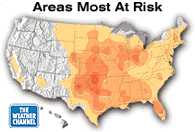Skip to comments.
Hurricanes' Lessons (Junk science alert; advice on science from the Arabs!!!)
Arab News ^
| 25 September 2005
| Arab News
Posted on 09/25/2005 6:34:16 PM PDT by indcons
MERCIFULLY the southern US appears to have escaped devastating human consequences from its second hurricane in a month. But can it also escape the lesson on climate change from the increase in powerful and possibly destructive tropical storms?
Rita was originally rated in the most ferocious category five with winds over 155 mph. As with all hurricanes, however, it lost power when it went ashore on the Louisiana and Texas coasts, dropping to a Category 3 and then 2 though as the coming hours will show, it has nonetheless caused plenty of damage.
Hurricane Katrina which smashed into New Orleans last month was a Category 4 storm with wind speeds of between 131 and 155 mph. Given that tropical storms are named alphabetically, it may at first seem puzzling that the list has suddenly jumped from K to R. In fact it has not. Since the destructive impact of Katrina, in the last four weeks, there have been the following: Lee, Maria, Nate, Ophelia, Philippe and now Rita. With two months of the four-month tropical storm season in the Atlantic to go, experts have predicted seven more storms, three of which could become major hurricanes. Thus it looks likely that for the first time ever the US National Hurricane Center will run out of the 21 pre-selected names. Once Stanley, Tammy, Vince, and Wilma have been recorded, they will begin using the Greek alphabet.
A hundred years ago, there were seldom more than a handful of tropical storms annually. Though some were ferocious, the damage they caused was a reflection of less sophisticated forecasting and poorer protection. Some storms which made no landfall may never have been recorded. It is however quite clear that a real increase has been taking place in the last 30 years. The question the Bush administration should be asking itself is why this is happening, along with all the other climactic change involved in global warming. The White House still rejects the link between carbon dioxide pollution, of which America is the biggest offender, and global warming. Five years ago, in one of his first acts as president, George Bush trashed the Kyoto Treaty which would have committed America to relatively modest reductions in its output of greenhouse gases. Big business supporters in the Republican Party feared the cost of cutting down pollution would cripple US international competitiveness, especially as emerging economic giants China and India would have longer to implement controls on carbon gas emissions. Bush argued that the science on the link between climate changes and greenhouse gases was not proven. The changes could simply be part of a natural climate cycle.
Even if this claim is right, the question now is can the US afford to reject the alternative? A larger number of more devastating hurricanes in future promises to impose a cost on America at least equal to, if not greater than, the price of cleaning up its pollution act. Five years have already been lost. Is the president finally going to sign up for Kyoto or will America continue to stubbornly plow yet another lonely political furrow?
TOPICS: Editorial; News/Current Events
KEYWORDS: climatechange; hurricanes; junkscience; katrina; lessons; muslimscience; rita
Navigation: use the links below to view more comments.
first previous 1-20, 21-22 last
To: indcons
I'm going to have to get a nuclear reactor to put out in the yard so I can stop burning all those fossil fuels. It has been awfully hot lately. But we've had a nice breeze blowing here in East Texas the last couple of days.
21
posted on
09/25/2005 9:34:14 PM PDT
by
KarinG1
To: ncountylee
Regarding tornados you are probably thinking of this chart:
Tornado frequency worldwide
|
B. Geerts and E. Linacre |
6/'98 |

Tornadoes have been reported widely (Table 1), especially in the central Great Plains of the USA (Fig 1), where they also can be most violent.
| Country or region |
Number of tornadoes per year per 105 km2 |
Fraction of strong tornadoes (F2-F5) |
| South Africa |
0.4 |
35% |
| Bangladesh |
0.6 |
? |
| Uruguay |
0.8 |
? |
| United Kingdom |
1.0 |
<10% |
| Sydney, Australia |
8 |
20-30% |
| Tornado alley (Oklahoma-Kansas, USA) |
40 |
42% |
Table 1. Tornado frequency and intensity in select geographical regions (1,2,3,4).

Fig 1. Tornado frequency in the USA. The frequency increases from grey to red (Source: the Weather Channel).
22
posted on
09/26/2005 12:50:23 PM PDT
by
muawiyah
(/ hey coach do I gotta' put in that "/sarcasm " thing again?)
Navigation: use the links below to view more comments.
first previous 1-20, 21-22 last
Disclaimer:
Opinions posted on Free Republic are those of the individual
posters and do not necessarily represent the opinion of Free Republic or its
management. All materials posted herein are protected by copyright law and the
exemption for fair use of copyrighted works.
FreeRepublic.com is powered by software copyright 2000-2008 John Robinson
![]()
